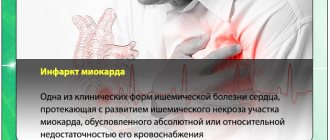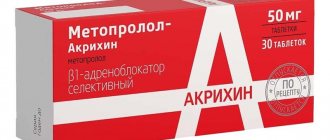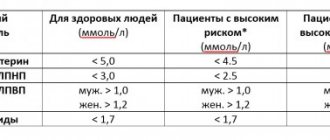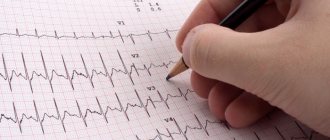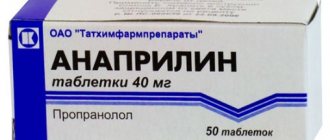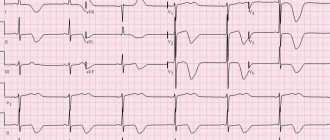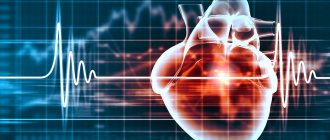Coronary heart disease is a lesion of the heart muscle that occurs as a result of a violation of the blood supply to the myocardium with arterial blood. The lumen of the coronary vessels narrows, atherosclerotic plaques settle on their walls, and as a result, the heart suffers from hypoxia (oxygen starvation). Ischemia requires proper treatment, otherwise the likelihood of death increases.
Treatment of ischemia should be comprehensive; one of the most important points is the use of medications. The decision on the choice of medications is made by the doctor based on an examination. Home treatment is possible, but the patient must take medications to treat coronary heart disease for life. If the patient's condition worsens, he is transported to the hospital and additional medications are prescribed.
Cardiac ischemia - basic information
Doctors distinguish the following forms of ischemia:
- Silent myocardial ischemia (SMI) occurs in patients with a high pain threshold. It develops as a result of hard physical work and excessive consumption of alcoholic beverages. The disease is not accompanied by pain. Characteristic symptoms: chest discomfort, increased heart rate, hypotension, left arm weakness, shortness of breath, etc.
- Sudden coronary death. The heart stops after an attack or several hours after it. Coronary death is followed by successful resuscitation or death. The heart stops due to obesity, smoking, and arterial hypertension. The main reason is ventricular fibrillation.
- Angina is a form of ischemic heart disease (coronary heart disease), which is manifested by compressive chest pain, discomfort, heartburn, intestinal cramps, and nausea. Pain from the chest radiates to the neck, left upper limb, and sometimes to the jaw or back on the same side. These symptoms appear after exercise, eating or increased blood pressure. The attack occurs against a background of stress or hypothermia. To stop the attack, which lasts about 15 minutes, avoid physical activity or take mild-acting nitrate-containing drugs (nitroglycerin).
- Myocardial infarction occurs against the background of strong emotional distress or physical stress due to the cessation of blood flow to the heart. The attack can last several hours. Cholesterol plaques on the walls of the vessel are destroyed, forming a clot that clogs the lumen of the vessel and provokes hypoxia. A characteristic symptom is chest pain, which does not disappear after taking nitroglycerin, accompanied by nausea, vomiting, difficulty breathing, and abdominal cramps. Diabetics may have no symptoms at all.
- With cardiosclerosis, cardiomyocytes (heart cells) die and are replaced by scar tissue, which does not participate in heart contraction. As a result, areas of the heart enlarge, valves become deformed, blood circulation is impaired and functional heart failure occurs.
With ischemia, the heart suffers from oxygen starvation
Thus, the disease is accompanied by chest pain, shortness of breath, irregular heartbeat, and malaise (weakness, vertigo, faintness, excessive sweating, nausea with vomiting). In addition, during an attack, the patient feels strong pressure or burning in the chest, anxiety, and panic.
Cardiac ischemia can occur due to atherosclerosis, poor diet, smoking, and alcohol abuse. The pathology is provoked by a passive lifestyle or intense physical activity, excess weight, and diabetes.
How do medications work for ischemic heart disease?
All drugs for ischemic heart disease are aimed at increasing oxygen saturation of the heart muscle, but this can be achieved in various ways. In addition to drugs that act directly on blood vessels, other means are used to complement their effect. Since IHD is often accompanied by hypertension, drugs with a hypotensive effect are used that gently lower blood pressure. For high cholesterol and obesity, lipid-lowering drugs are prescribed, that is, they reduce the level of lipids in the blood.
Thanks to them, fats stop depositing on the walls of blood vessels, forming atherosclerotic plaques, leading to diseases of the cardiovascular system.
These are mainly statins - Lovastatin, Atorvastatin and other drugs that the doctor selects with extreme caution to avoid side effects.
Since narrowed blood vessels often provoke dizziness and rapid heartbeat, doctors are sure to select all medications in combination so that they do not interact negatively, but complement each other. If there is a tendency to thrombosis, blood thinning drugs are prescribed, mainly Aspirin Cardio in a low dosage.
But the main drugs that are used for ischemic heart disease and heart failure are drugs with antianginal action. These medications are aimed at increasing the lumen of the vessel and improving the supply of oxygen to the heart, as well as reducing the myocardial oxygen demand.
If medications do not help with severe cardiac ischemia, the only option left is surgery. The operation can be performed in the form of coronary artery bypass grafting or intraluminal percutaneous angioplasty.
To improve the patient’s condition in the initial stages of the disease and during remission, moderate physical activity is recommended, mainly swimming, walking,
Drug treatment regimen
The treatment regimen for IHD is selected depending on the clinical picture for each patient individually. Complex therapy consists of the following points:
- treatment without the use of medications;
- drug therapy;
- endovascular coronary angioplasty (minimally invasive procedure in the area of myocardial vessels);
- other methods of therapy.
Antiplatelet agents, statins, angiotensin II receptor antagonists and other drugs are used to treat ischemic heart disease.
The question of what measures to take in each individual case is decided by the cardiologist.
Complex therapy stops the progression of the disease, alleviates negative symptoms, and increases the patient’s length and quality of life.
Doctors identify medications for coronary heart disease that improve the prognosis:
- Antiplatelet agents are medications that reduce thrombosis by inhibiting platelet aggregation (sticking together).
- Statins reduce the production of cholesterol in the liver, thereby reducing its concentration in the bloodstream.
- Antagonists of the renin-angiotensin-aldosterone system prevent arterial hypertension.
For symptomatic treatment, β-blockers, sinus node if-channel inhibitors, slow calcium channel blockers, and potassium channel openers are used. In addition, nitrates and antihypertensive drugs are actively used to eliminate symptoms.
As mentioned earlier, the patient must take anti-ischemic drugs throughout his life. The decision to prescribe medication, change the drug and change the dosage is made by the cardiologist. However, complete treatment includes diet, moderate physical activity, normalization of sleep patterns and giving up bad habits.
Antiplatelet agents
Such drugs are necessary to prevent blood clots. Under the influence of these medications, the aggregation of platelets and red blood cells is inhibited. As a result, their ability to stick together and adhere to the vascular endothelium is reduced.
By reducing the surface tension of red blood cell membranes, their damage during passage through the capillaries is reduced. As a result, blood flow improves.
In the treatment of ischemic heart disease, acetylsalicylic acid is often used, which is the basis of Aspirin, Acecardol, and Thrombolol. Take such drugs once a day in a dosage of at least 75 mg.
Another effective antiplatelet agent is Clopidogrel. Such drugs as Plavix and Clopidogrel are based on this substance. It is also taken once a day, 75 mg.
Antiplatelet agents provide not only the prevention of aggregation, but are also capable of disaggregating aggregated platelets.
Antiplatelet medications
Medicines that thin the blood by reducing its clotting are called antiplatelet agents (antiplatelet drugs). These agents prevent the sticking (aggregation) of platelets and red blood cells and reduce the likelihood of blood clots forming in the vessels.
Aspirin prevents blood clots
Antiplatelet agents are used for complex therapy of cardiac ischemia:
- Acetylsalicylic acid (Aspirin) is the main remedy for preventing thrombosis. The drug is contraindicated for peptic ulcers and diseases of the hematopoietic organs. The medication is effective, relatively safe and inexpensive. To avoid adverse reactions, you should follow the rules for taking the drug.
- Clopidogrel acts similarly to Aspirin; the medication is used for hypersensitivity to the components of acetylsalicylic acid.
- Warfarin helps break up blood clots and maintains blood clotting levels. Tablets are prescribed only after a complete diagnosis and with a systematic blood test for INR (an indicator reflecting the rate of blood clot formation). This is necessary, since the drug can cause hemorrhage.
Antiplatelet agents are used only for medical reasons.
Diagnostics
At a young age, the diagnosis is made by an ECG taken during stress tests (test with an exercise bike or treadmill). In old age, such diagnosis is difficult due to the risk of complications. Therefore, the diagnosis is made by:
- daily ECG monitoring (Holter), which can be performed at home;
- Ultrasound of the heart to determine how it contracts, how much blood it releases during systole;
- radionuclide scintigraphy of the myocardium (if possible). This test identifies areas of ischemia and poor myocardial motility. This study can be replaced by PET-CT if it is performed in your city.
If these three tests show ischemia, the need for coronary angiography - the injection of a contrast agent into the vessels of the heart and subsequent x-rays - should be considered. This study helps to assess the patency of blood vessels and, if necessary, plan the extent of surgery to increase the diameter of the vessel.
Lipid-lowering drugs
Patients should monitor their blood cholesterol levels; doctors consider the following numbers to be normal:
- Total cholesterol is about 5 mmol/l.
- Low-density lipoproteins (the main carriers of cholesterol) – 3 mmol/l.
- High-density lipoproteins (compounds that transport fats to the liver for processing) – 1 mmol/l.
Statins lower blood cholesterol levels
In addition, it is worth paying attention to the atherogenicity coefficient (the degree of risk of cardiovascular diseases) and the level of neutral fats. In severe cases, when the underlying disease is accompanied by diabetes mellitus, these values must be constantly monitored.
To achieve these goals, the patient must adhere to a diet and take special medications. Only complex treatment guarantees a good and lasting therapeutic effect.
To reduce the concentration of cholesterol during ischemia, statins are used: Rosuvastatin, Atorvastatin, Simvastatin, etc. The attending physician is responsible for prescribing medications.
Angiotensin II receptor antagonists
The list of medications for ischemia includes drugs that normalize blood pressure. Arterial hypertension negatively affects the condition of myocardial vessels. Without treatment of hypertension, the likelihood of progression of ischemia, stroke, and chronic functional heart failure increases.
Angiotensin receptor inhibitors reduce blood pressure
Angiotensin receptor inhibitors are medications that block angiotensin-2 receptors (an enzyme localized in cardiac tissue), they lower blood pressure, prevent hypertrophy (increase in the volume and weight of the organ) or shrinkage of the heart. Such drugs are taken for a long time under medical supervision.
Angiotensin-converting enzyme inhibitors (ACEIs) block the activity of angiotensin II, which increases blood pressure. The enzyme negatively affects the muscle tissue of the heart and blood vessels. The patient's condition improves when he uses the following drugs from the ACE group:
- Lisinopril,
- Perindopril,
- Enalapril,
- Ramipril.
To treat cardiac ischemia, angiotensin-II receptor blockers are used: Losartan, Candesartan, Telmisartan, etc.
Use of β-blockers
Beta-blockers (BABs) have a beneficial effect on heart function. BBs normalize heart rate and stabilize blood pressure. They are prescribed for arrhythmia as stress hormone blockers. Drugs from this group eliminate the signs of angina pectoris. Doctors prescribe β-blockers to patients after a heart attack.
BBs normalize heart function and eliminate symptoms of angina pectoris
The following beta blockers are used to treat cardiac ischemia:
We advise you to read: Indications for the use of antiplatelet agents
- Oxprenolol,
- Nadolol,
- Propranolol,
- Bisoprolol,
- Metoprolol,
- Carvedilol,
- Nebivolol, etc.
Before using the medicine, you should consult your doctor.
Calcium channel blockers
Drug treatment of cardiac ischemia is carried out using drugs that block L-type calcium channels. They are intended to prevent angina attacks. Calcium antagonists relieve symptoms of arrhythmia by reducing the frequency of myocardial contraction. In most cases, these medications are used to prevent ischemia, as well as for angina at rest.
Calcium antagonists eliminate signs of arrhythmia
The most effective drugs include the following:
- Verapamil,
- Parnavel-Amlo,
- Diltiazem-Retard,
- Nifedipine.
To avoid adverse reactions, medications are taken only for medical reasons.
Treatment of chronic coronary heart disease
Ischemic (coronary) heart disease (CHD), which develops as a result of atherosclerosis of the coronary arteries, is the leading cause of disability and mortality in the working population throughout the world. In Russia, the prevalence of cardiovascular diseases and coronary artery disease is growing, and in terms of mortality from them, our country is one of the first places in the world, which necessitates the use of modern and effective methods of their treatment and prevention by doctors. Among the population of Russia, the prevalence of the main risk factors for the development of coronary artery disease remains high, of which smoking, arterial hypertension, and hypercholesterolemia are the most important.
Atherosclerosis is the main cause of the development of coronary artery disease. It proceeds covertly for a long time until it leads to complications such as myocardial infarction, cerebral stroke, sudden death, or to the appearance of angina pectoris, chronic cerebrovascular insufficiency, and intermittent claudication. Atherosclerosis leads to gradual local stenosis of the coronary, cerebral and other arteries due to the formation and growth of atherosclerotic plaques in them. In addition, such factors as endothelial dysfunction, regional spasms, impaired microcirculation, as well as the presence of a primary inflammatory process in the vascular wall as a possible factor in the formation of thrombosis take part in its development [1]. An imbalance of vasodilating and vasoconstrictor stimuli can also significantly change the state of the tone of the coronary arteries, creating additional dynamic stenosis to the already existing fixed one.
The development of stable angina can be predictable, for example, in the presence of factors that cause an increase in myocardial oxygen demand, such as physical or emotional stress (stress).
Patients with angina pectoris, including those who have already suffered a myocardial infarction, constitute the largest group of patients with coronary artery disease. This explains the interest of practicing physicians in the issues of proper management of patients with angina pectoris and the choice of optimal treatment methods.
Clinical forms of IHD . IHD manifests itself in many clinical forms: chronic stable angina, unstable (progressive) angina, asymptomatic IHD, vasospastic angina, myocardial infarction, heart failure, sudden death. Transient myocardial ischemia, usually resulting from narrowing of the coronary arteries and increased oxygen demand, is the main mechanism for the development of stable angina.
Chronic stable angina is usually divided into 4 functional classes according to the severity of symptoms (Canadian classification).
The main goals of treatment are to improve the patient's quality of life by reducing the frequency of angina attacks, preventing acute myocardial infarction, and improving survival. Antianginal treatment is considered successful in the case of complete or almost complete elimination of angina attacks and the patient’s return to normal activity (angina pectoris not higher than functional class I, when painful attacks occur only under significant loads) and with minimal side effects of therapy [2, 3].
In the treatment of chronic ischemic heart disease, 3 main groups of drugs are used: β-blockers, calcium antagonists, organic nitrates, which significantly reduce the number of angina attacks, reduce the need for nitroglycerin, increase exercise tolerance and improve the quality of life of patients.
However, medical practitioners are still reluctant to prescribe new effective drugs in sufficient doses. In addition, if there is a large selection of modern antianginal and anti-ischemic drugs, outdated and insufficiently effective ones should be excluded. A frank conversation with the patient, an explanation of the cause of the disease and its complications, and the need for additional non-invasive and invasive research methods helps to choose the right treatment method.
According to the results of the ATP-survey (Angina Treatment Patterns), in Russia, when choosing antianginal drugs with a hemodynamic mechanism of action in monotherapy, preference is given to nitrates (11.9%), then b-blockers (7.8%) and calcium antagonists (2 .7%) [4].
β-blockers are the first choice drugs for the treatment of patients with angina pectoris, especially in patients who have had a myocardial infarction, as they lead to a reduction in mortality and the incidence of recurrent infarction. Drugs of this group have been used in the treatment of patients with coronary artery disease for more than 40 years.
β-blockers cause an antianginal effect by reducing the myocardial oxygen demand (due to a decrease in heart rate, lowering blood pressure and myocardial contractility), increasing oxygen delivery to the myocardium (due to increased collateral blood flow, its redistribution in favor of the ischemic layers of the myocardium - subendocardium ), antiarrhythmic and antiaggregation effects, reducing calcium accumulation in ischemic cardiomyocytes.
Indications for the use of β-blockers are the presence of angina, angina with concomitant arterial hypertension, concomitant heart failure, “silent” myocardial ischemia, myocardial ischemia with concomitant rhythm disturbances. In the absence of direct contraindications, β-blockers are prescribed to all patients with coronary artery disease, especially after myocardial infarction. The goal of therapy is to improve the long-term prognosis of a patient with coronary artery disease.
Among β-blockers, propranolol (80–320 mg/day), atenolol (25–100 mg/day), metoprolol (50–200 mg/day), carvedilol (25–50 mg/day), bisoprolol (5 - 20 mg/day), nebivolol (5 mg/day). Cardioselective drugs (atenolol, metoprolol, betaxolol) have a predominantly blocking effect on β1-adrenergic receptors.
One of the most widely used cardioselective drugs is atenolol (tenormin). The initial dose is 50 mg/day. In the future, it can be increased to 200 mg/day. The drug is prescribed once in the morning. In case of severe renal impairment, the daily dose should be reduced.
Another cardioselective β-blocker is metoprolol (Betaloc). Its daily dose is on average 100–300 mg, the drug is prescribed in 2 doses, since the β-blocking effect can be observed for up to 12 hours. At present, long-acting metoprolol preparations have become widespread - betaloc ZOK, metocard, the duration of the effect of which reaches 24 hours.
Bisoprolol (Concor), in comparison with atenolol and metoprolol, has more pronounced cardioselectivity (in therapeutic doses it blocks only β1-adrenergic receptors) and a longer duration of action. It is used once a day at a dose of 2.5–20 mg.
Carvedilol (Dilatrend) has a combined non-selective β-, α1-blocking and antioxidant effect. The drug blocks both β1- and β2-adrenergic receptors, without having its own sympathomimetic activity. Due to the blockade of α1-adrenergic receptors located in the smooth muscle cells of the vascular wall, carvedilol causes pronounced vasodilation. Thus, it combines β-adrenergic blocking and vasodilating activity, which is mainly responsible for its antianginal and anti-ischemic effect, which persists with long-term use. Carvedilol also has a hypotensive effect and inhibits the proliferation of smooth muscle cells, which plays a proatherogenic role. The drug is able to reduce the viscosity of blood plasma, aggregation of erythrocytes and platelets. In patients with impaired left ventricular (LV) function or circulatory failure, carvedilol has a beneficial effect on hemodynamic parameters (reduces pre- and afterload), increases ejection fraction and reduces LV size. Thus, the administration of carvedilol is indicated primarily for patients with coronary artery disease who have suffered a myocardial infarction, with heart failure, since in this group of patients its ability to significantly improve the prognosis of the disease and increase life expectancy has been proven. When comparing carvedilol (average daily dose 20.5 mg) and atenolol (average daily dose 25.9 mg), it was shown that both drugs, prescribed 2 times a day, are equally effective in the treatment of patients with stable angina pectoris [5]. One of the guidelines for the adequacy of the dose of beta-blockers used is a decrease in heart rate at rest to 55–60 beats/min. In some cases, in patients with severe angina, resting heart rate may be reduced to less than 50 beats/min.
Nebivolol (nebilet) is a new selective β1-blocker that also stimulates the synthesis of nitric oxide (NO). The drug causes hemodynamic unloading of the heart: it reduces blood pressure, pre- and afterload, increases cardiac output, and increases peripheral blood flow. Nebivolol is a b-blocker with unique properties, which lie in the ability of the drug to participate in the process of synthesis of relaxing factor (NO) by endothelial cells. This property gives the drug an additional vasodilating effect. The drug is used primarily in patients with arterial hypertension with attacks of angina pectoris.
Celiprolol (200–600 mg/day) - a third-generation β-blocker - differs from other β-blockers in its high selectivity, moderate stimulation of β2-adrenergic receptors, direct vasodilating effect on blood vessels, modulation of the release of nitric oxide from endothelial cells, and the absence of adverse metabolic effects. The drug is recommended for patients with coronary artery disease with chronic obstructive pulmonary diseases, dyslipidemia, diabetes mellitus, and peripheral vascular diseases caused by tobacco smoking [6]. Celiprolol (200–600 mg/day), atenolol (50–100 mg/day), propranolol (80–320 mg/day) have comparable antianginal efficacy and equally increase exercise tolerance in patients with stable angina pectoris.
β-blockers should be given preference when prescribed to patients with coronary artery disease if there is a clear connection between physical activity and the development of an angina attack, with concomitant arterial hypertension; the presence of rhythm disturbances (supraventricular or ventricular arrhythmia), previous myocardial infarction, severe anxiety. Most of the adverse effects of β-blockers are due to blockade of β2 receptors. The need to monitor the prescription of β-blockers and the side effects encountered (bradycardia, hypotension, bronchospasm, increased signs of heart failure, heart block, sick sinus syndrome, fatigue, insomnia) lead to the fact that the doctor does not always use these drugs. The main medical errors when prescribing β-blockers are the use of small doses of drugs, their administration less frequently than necessary, and the discontinuation of drugs when a heart rate at rest is less than 60 beats/min. One should also keep in mind the possibility of developing withdrawal syndrome, and therefore β-blockers must be discontinued gradually.
Calcium channel blockers (calcium antagonists). The main point of application of drugs of this group at the cellular level are slow calcium channels, through which calcium ions pass into the smooth muscle cells of blood vessels and the heart. In the presence of calcium ions, actin and myosin interact, ensuring contractility of the myocardium and smooth muscle cells. In addition, calcium channels are involved in the generation of pacemaker activity of sinus node cells and conduction of impulses through the atrioventricular node.
It has been established that the vasodilating effect caused by calcium antagonists occurs not only through a direct effect on the smooth muscles of the vascular wall, but also indirectly, through potentiation of the release of nitric oxide from the vascular endothelium. This phenomenon has been described for most dihydropyridines and isradipine, and to a lesser extent for nifedipine and non-hydropyridine drugs. For long-term treatment of angina from dihydropyridine derivatives, it is recommended to use only prolonged dosage forms or long-acting generations of calcium antagonists. Calcium channel blockers are powerful vasodilators; they reduce myocardial oxygen demand and dilate coronary arteries. The drugs can be used for vasospastic angina and concomitant obstructive pulmonary diseases. Additional indications for the prescription of calcium antagonists are Raynaud's syndrome, as well as (for phenylalkylamines - verapamil and benzodiazepines - diltiazem) atrial fibrillation, supraventricular tachycardia, hypertrophic cardiomyopathy. The following calcium antagonists are used in the treatment of coronary heart disease: nifedipine, immediate action 30–60 mg/day (10–20 mg 3 times) or prolonged action (30–180 mg once); immediate-release verapamil (80–160 mg 3 times daily); or prolonged action (120–480 mg once); immediate-release diltiazem (30–60 mg 4 times a day) or long-acting (120–300 mg/day once); long-acting drugs amlodipine (5–10 mg/day once), lacidipine (2–4 mg/day).
Activation of the sympathoadrenal system by dihydropyridines (nifedipine, amlodipine) is currently considered as an undesirable phenomenon and is considered the main reason for a slight increase in mortality in patients with coronary artery disease when taking short-acting dihydropyridines for unstable angina, acute myocardial infarction and, apparently, with long-term use in patients with stable angina pectoris . In this regard, it is currently recommended to use retard and prolonged forms of dihydropyridines. They have no fundamental differences in the nature of pharmacodynamic action with short-acting drugs. Due to gradual absorption, they are devoid of a number of side effects associated with sympathetic activation, so characteristic of short-acting dihydropyridines.
In recent years, evidence has emerged indicating the possibility of slowing down damage to the vascular wall with the help of calcium antagonists, especially in the early stages of the development of atherosclerosis.
Amlodipine (Norvasc, Amlovas, Nordipine) is a third generation calcium antagonist from the group of dihydropyridines. Amlodipine dilates peripheral blood vessels and reduces cardiac afterload. Due to the fact that the drug does not cause reflex tachycardia (since the sympathoadrenal system is not activated), energy consumption and myocardial oxygen demand are reduced. The drug dilates the coronary arteries and increases the supply of oxygen to the myocardium. Antianginal effect (reducing the frequency and duration of angina attacks, daily requirement for nitroglycerin), increasing tolerance to physical activity, improving systolic and diastolic heart function in the absence of a depressing effect on the sinus and atrioventricular node and other elements of the conduction system of the heart put the drug in one of the first places in the treatment of angina pectoris.
Lacidipine, a third-generation drug from the class of calcium antagonists, has high lipophilicity, interaction with the cell membrane, and independence of tissue effects from its concentration. These factors are leading in the mechanism of antiatherosclerotic action. Lacidipine has a positive effect on the endothelium, inhibits the formation of adhesion molecules, proliferation of smooth muscle cells and platelet aggregation. In addition, the drug is able to inhibit the peroxidation of low-density lipoproteins, i.e., it can affect one of the early stages of plaque formation.
The European Lacidipine Study on Atherosclerosis (ELSA) compared the intima-media thickness of the carotid artery in 2334 patients with arterial hypertension during 4 years of therapy with lacidipine or atenolol. In the patients included in the study, the carotid arteries were initially normal and/or altered. Treatment with lacidipine was accompanied by a significantly more pronounced decrease in intima-media thickness, both at the level of the bifurcation and the common carotid artery, compared to atenolol. During treatment with lacidipine compared with atenolol, the increase in the number of atherosclerotic plaques in patients was 18% less, and the number of patients in whom the number of plaques decreased was 31% more [7].
Thus, calcium antagonists, along with pronounced antianginal (anti-ischemic) properties, can have an additional anti-atherogenic effect (stabilization of the plasma membrane, preventing the penetration of free cholesterol into the vessel wall), which allows them to be prescribed more often to patients with stable angina pectoris with damage to arteries of different localizations. Currently, calcium antagonists are considered second-line drugs in patients with angina pectoris, following β-blockers. As monotherapy, they can achieve the same pronounced antianginal effect as β-blockers. The undoubted advantage of β-blockers over calcium antagonists is their ability to reduce mortality in patients who have had myocardial infarction. Studies of the use of calcium antagonists after myocardial infarction have shown that the greatest effect is achieved in individuals without severe left ventricular dysfunction, suffering from arterial hypertension, and having had a myocardial infarction without a Q wave.
Thus, the undoubted advantage of calcium antagonists is a wide range of pharmacological effects aimed at eliminating the manifestations of coronary insufficiency: antianginal, hypotensive, antiarrhythmic. Therapy with these drugs also has a beneficial effect on the course of atherosclerosis.
Organic nitrates . The anti-ischemic effect of nitrates is based on a significant change in hemodynamic parameters: a decrease in pre- and afterload of the left ventricle, a decrease in vascular resistance, including coronary arteries, a decrease in blood pressure, etc. The main indications for taking nitrates are angina pectoris and rest in patients with coronary artery disease (also in in order to prevent them), attacks of vasospastic angina, attacks of angina, accompanied by manifestations of left ventricular failure.
Sublingual nitroglycerin (0.3–0.6 mg) or nitroglycerin aerosol (Nitromint 0.4 mg) is intended for the relief of acute attacks of angina due to the rapid onset of action. If nitroglycerin is poorly tolerated, nitrosorbide, molsidomine or the calcium antagonist nifedipine can be used to relieve an attack of angina, chewing or dissolving the tablets when taking them under the tongue.
Organic nitrates (preparations of isosorbide dinitrate or isosorbide-5-mononitrate) are used to prevent angina attacks. These drugs provide long-term hemodynamic unloading of the heart, improve blood supply to ischemic areas and increase physical performance. They try to prescribe them before physical activity that causes angina. Of the drugs with proven effectiveness, the most studied are cardiquet (20, 40, 60 and 120 mg/day), nitrosorbide (40–80 mg/day), olicard retard (40 mg/day), mono poppy (20–80 mg/day ), mono mac depot (50 and 100 mg/day), efox long (50 mg/day), mono cinque retard (50 mg/day). For patients with stable angina pectoris class I-II, intermittent administration of nitrates is possible before situations that can cause an attack of angina. For patients with more severe angina pectoris class III-IV, nitrates should be prescribed regularly; In such patients, one should strive to maintain the effect throughout the day. In case of class IV angina (when angina attacks can also occur at night), nitrates should be prescribed in such a way as to ensure an effect throughout the day [8].
Nitrate-like drugs include molsidomine (Corvaton, Sidnopharm, Dilasidom), a drug that differs from nitrates in chemical structure, but is no different from them in its mechanism of action. The drug reduces vascular wall tension, improves collateral circulation in the myocardium, and has anti-aggregation properties. Comparable doses of isosorbide dinitrate and corvatone are 10 mg and 2 mg, respectively. The effect of Corvaton appears after 15–20 minutes, the duration of action is from 1 to 6 hours (on average 4 hours). Corvaton retard 8 mg is taken 1-2 times a day, since the effect of the drug lasts more than 12 hours.
The weakness of nitrates is the development of tolerance to them, especially with long-term use, and side effects that complicate their use (headache, palpitations, dizziness), caused by reflex sinus tachycardia. Transdermal forms of nitrates in the form of ointments, patches and discs, due to the difficulty of dosing them and the development of tolerance to them, have not found widespread use. It is also unknown whether nitrates improve the prognosis of a patient with stable angina with long-term use, which makes the advisability of their use in the absence of angina pectoris (myocardial ischemia) questionable.
When prescribing drugs with a hemodynamic mechanism of action in elderly patients, the following rules should be observed: start treatment with lower doses, carefully monitor unwanted effects, and always consider changing the drug if it is poorly tolerated and insufficiently effective.
Combination therapy . Combination therapy with antianginal drugs in patients with stable angina of class III-IV is carried out for the following indications: impossibility of selecting effective monotherapy; the need to enhance the effect of monotherapy (for example, during periods of increased physical activity of the patient); correction of unfavorable hemodynamic changes (for example, tachycardia caused by nitrates or calcium antagonists from the dihydropyridine group); when angina is combined with arterial hypertension or heart rhythm disturbances that are not compensated for in cases of monotherapy; in case of patient intolerance to generally accepted doses of drugs during monotherapy, small doses of drugs can be combined to achieve the desired effect.
The synergism of the mechanisms of action of various classes of antianginal drugs is the basis for assessing the prospects of their combinations. When treating a patient with stable angina, doctors often use various combinations of antianginal drugs (β-blockers, nitrates, calcium antagonists). In the absence of effect from monotherapy, combination therapy is often prescribed (nitrates and β-blockers; β-blockers and calcium antagonists, etc.).
The results of the ATP-survey study (review of the treatment of stable angina) showed that in Russia 76% of patients receive combination therapy with hemodynamic drugs, while in more than 40% of cases - a combination of nitrates and b-blockers [4]. However, their additive effects have not been confirmed in all studies. The guidelines of the European Society of Cardiology (1997) indicate that if one antianginal drug is ineffective, it is better to first evaluate the effect of another, and only then use the combination [9]. The results of pharmacological controlled studies do not confirm that combination therapy with a beta-blocker and a calcium antagonist is accompanied by a positive additive and synergistic effect in the majority of patients with coronary artery disease. Prescribing 2 or 3 drugs in combination is not always more effective than therapy with one drug at an optimal dose [10]. We must not forget that the use of multiple drugs significantly increases the risk of adverse events associated with effects on hemodynamics.
The modern approach to combination therapy of patients with stable angina pectoris implies the advantage of combining antianginal drugs with multidirectional effects: hemodynamic and cytoprotective.
The main disadvantages of domestic pharmacotherapy for stable angina include the often erroneous, according to modern concepts, choice of a group of antianginal drugs (as a rule, nitrates are prescribed (80%)), the frequent use of clinically insignificant dosages and the unreasonable prescription of combination therapy with a large number of antianginal drugs [4] .
Metabolic agents. Trimetazidine (preductal) causes inhibition of fatty acid oxidation (by blocking the enzyme 3-ketoacyl-coenzyme A-thiolase) and stimulates the oxidation of pyruvate, i.e., it switches myocardial energy metabolism to glucose utilization. The drug protects myocardial cells from the adverse effects of ischemia, while reducing intracellular acidosis, metabolic disorders and damage to cell membranes. A single dose of trimetazidine is not able to relieve or prevent an attack of angina. Its effects are observed mainly during combination therapy with other antianginal drugs or during a course of treatment. Preductal is effective and well tolerated, especially in groups at high risk of developing coronary complications, such as patients with diabetes mellitus, the elderly and those with left ventricular dysfunction.
The combination of preductal with propranolol was significantly more effective than the combination of this β-blocker with nitrate. Trimetazidine (preductal 60 mg/day), preductal MB (70 mg/day) have an anti-ischemic effect, but more often they are used in combination with basic hemodynamic antianginal drugs.
In Russia, a multicenter, single-blind, randomized, placebo-controlled, parallel-group study, TAST (Trimetazidin in patients with Angina in Combination Therapy), was conducted, which included 177 patients suffering from class II-III angina, partially relieved by nitrates and β-blockers, to evaluate the effectiveness of the preductal in combination therapy with nitrates or β-blockers. Evaluation of the effectiveness of treatment was carried out according to the following criteria: time until the onset of ST segment depression by 1 mm during stress tests, time of onset of angina pectoris, increase in the duration of the stress test. It was found that the preductal significantly increased these indicators. There are a number of clinical situations in which trimetazidine, apparently, can be the drug of choice in elderly patients, with circulatory failure of ischemic origin, sick sinus syndrome, with intolerance to antianginal drugs of the main classes, as well as with restrictions or contraindications to their use [eleven].
Drugs with antianginal properties include amiodarone and other “metabolic” drugs (ranolazine, L-arginine), as well as ACE inhibitors, selective heart rate inhibitors (ivabradine, procolaran). They are used mainly as an adjuvant therapy, prescribed in addition to the main antianginal drugs [12, 17].
The problem of drug treatment of patients with coronary artery disease is the patients’ insufficient adherence to the chosen therapy and their insufficient willingness to consistently change their lifestyle. During drug treatment, proper regular contact between the doctor and the patient is necessary, informing the patient about the nature of the disease and the benefits of prescribed drugs to improve the prognosis. When trying to influence the prognosis of a patient’s life with the help of drug therapy, the doctor must be sure that the medications he prescribes are actually taken by the patient, and in appropriate doses and according to the recommended treatment regimen.
Surgery . If drug therapy is ineffective, surgical treatment methods are used (myocardial revascularization procedures), which include: percutaneous transluminal coronary angioplasty, implantation of coronary stents, coronary artery bypass surgery. In patients with coronary artery disease, it is important to determine individual risk based on clinical and instrumental indicators, which depends on the corresponding clinical stage of the disease and the treatment provided. Thus, the maximum effectiveness of coronary bypass surgery was observed in patients with the highest preoperative risk of developing cardiovascular complications (with severe angina and ischemia, extensive lesions of the coronary arteries, impaired LV function). If the risk of complications of coronary artery disease is low (single artery disease, absence or mild ischemia, normal LV function), surgical revascularization is usually not indicated until the ineffectiveness of drug therapy or coronary angioplasty has been established. When deciding whether to use coronary angioplasty or coronary bypass surgery to treat patients with damage to multiple coronary arteries, the choice of method depends on the anatomical features of the coronary bed, LV function, the need to achieve complete myocardial revascularization and patient preferences [13].
Thus, with the methods of combating cardiovascular diseases that exist today (Table), it is important for the doctor to be aware of the latest advances in medicine and make the right choice of treatment method.
For questions regarding literature, please contact the editor.
D. M. Aronov , Doctor of Medical Sciences, Professor V. P. Lupanov , Doctor of Medical Sciences, State Research Center for Preventive Medicine of the Ministry of Health of the Russian Federation, Institute of Clinical Cardiology named after. A. L. Myasnikov Russian Cardiological Research and Production Complex of the Ministry of Health of the Russian Federation, Moscow
Nitrates against ischemic heart disease
With the help of nitrates and nitrate-like drugs, they eliminate the symptoms of angina pectoris and prevent complications of acute coronary heart disease. Nitrates relieve pain, dilate myocardial vessels, reduce blood flow to the heart, which is why the organ needs less oxygen.
Nitroglycerin relieves pain and dilates coronary vessels
For IHD, the following medications are prescribed:
- Nitroglycerin in the form of sublingual (under the tongue) tablets and drops for inhalation.
- Nitroglycerin ointment, disc or patches.
- Isosorbitol dinitrate.
- Isosorbitol mononitrate.
- Mononitrate.
Molsidomine is used for hypersensitivity to nitrates.
Contraindications
ß-blockers have a number of prohibitions for use, including obstructive pulmonary pathologies, weakness of the sinus node, slowing of the rhythm, hypotension, as well as atrioventricular block (starting from the second stage). The issue with bronchospasm has been partially resolved - Nebivalol reduces heart rate without causing respiratory discomfort. It is approved for use by people with atopy if the benefits of the prescription outweigh the possible risks.
The main contraindications to nitrates are hypotension, hypovolemia, acute myocardial infarction, hemorrhagic stroke, pericarditis.
Contraindications to the use of anticoagulants:
- hemorrhage from the gastrointestinal tract;
- stomach ulcer or DC;
- bronchospasm;
- oncological processes.
Antihypertensive drugs
Drugs from this group reduce high blood pressure. This effect is achieved by drugs from different pharmacological classes with different mechanisms of action.
Diuretics, beta blockers, calcium channel blockers, ACE inhibitors will help reduce pressure during ischemia
Antihypertensive drugs for cardiac ischemia include diuretics (diuretics). These medications lower blood pressure and, in higher dosages, remove excess tissue from the body. Effective diuretics - Furosemide, Lasix.
As mentioned earlier, β-blockers, calcium channel blockers, and ACE inhibitors have a hypotensive effect:
- Cilazopril,
- Captopril,
- Coexipril,
- Quinapril,
- Perindopril,
- Cilazapril.
It is strictly not recommended to prescribe medications on your own.
Other medicines
An if-channel sinus node inhibitor called ivabradine reduces heart rate but does not affect heart muscle contractility or blood pressure. The drug is used for the treatment of stable angina pectoris with hypersensitivity to beta-blockers. Sometimes these medications are prescribed together to improve the prognosis of the disease.
Ivabradine and Nicorandil are used as part of complex treatment
The opener of potassium channels Nicorandil promotes the dilation of myocardial vessels and prevents the formation of cholesterol plaques. The drug does not affect heart rate and blood pressure. It is used for cardiac syndrome X (microvascular angina). Nicorandil prevents and eliminates the symptoms of the disease.
Treatment of Prinzmetal's angina
This form of angina pectoris is manifested by pain, pressure, burning in the chest, even at rest. Such symptoms occur due to spasm of blood vessels that transport blood to the myocardium. The lumen of the coronary vessel narrows, and blood flows to the heart with difficulty.
Symptoms of Prinzmetal's angina appear even in a calm state
Calcium channel blockers are taken to prevent attacks. In case of exacerbation of the disease, Nitroglycerin and long-acting nitrates are prescribed. In some cases, calcium channel blockers and β-blockers are combined. In addition to taking medications, it is recommended to avoid smoking, stress, and hypothermia.
Causes and symptoms of IHD
Risk factors for the development of ischemia are:
- male person;
- age over 40 years;
- hereditary predisposition;
- smoking for a long time and in large doses: more than 10 cigarettes per day;
- elevated cholesterol and blood sugar;
- hypertension;
- obesity;
- physical inactivity.
Drug treatment will not be effective if a person leads an unhealthy lifestyle.
The lumen of the artery narrows more and more. If the lumen area is reduced by more than 90%, the patient's condition becomes critical, even if he is at rest.
To maximize the effect of medications, you must:
- get rid of bad habits: alcohol, smoking, including passive smoking, strong or carbonated soft drinks;
- monitor cholesterol and blood sugar levels;
- take measures to maintain normal blood pressure;
- change your diet in favor of low-fat and low-calorie foods to combat excess weight. The diet should be varied and healthy, with a sufficient content of vitamins and minerals, with a minimum salt content and limited water consumption;
- get enough rest;
- move more, but heavy physical activity is contraindicated;
- harden the body.
The main symptoms of cardiac ischemia:
- Pain in the chest when walking, forcing you to stop. This happens especially often after eating.
- The pain does not go away for a long time, even if the person stops.
- Pain will occur not only when walking, but also when lying down.
- The pain begins to radiate to the lower jaw, left shoulder, neck, back.
- The nature of the pain is pressing, squeezing, burning, suffocating.
- Intensifies with physical or emotional stress and lasts up to 15 minutes.
- When taking Nitroglycerin, the pain calms down.
Microvascular angina
The disease manifests itself as chest pain without structural changes in the myocardial vessels. Diabetics or hypertensive patients suffer from microvascular angina. If pathological processes are present in the microvascular system of the heart, doctors prescribe the following drugs:
- Statins,
- Antiplatelet agents,
- ACE inhibitors,
- Ranolazine.
Hypertensive patients and diabetics most often suffer from microvascular angina.
To relieve pain, beta-blockers, calcium antagonists, and long-acting nitrates are taken.
Emergency medications for cardiac ischemia
In case of IHD, it is necessary first of all to relieve painful sensations; for this purpose, the following drugs are used:
- Nitroglycerin quickly relieves chest pain, which is why it is often prescribed as an emergency treatment. If necessary, the drug can be replaced with Isoket or Nitrolingval, only a single dose of the medication is used. It is better to sit down while taking the medicine, otherwise there is a possibility of loss of consciousness due to a sharp decrease in pressure.
- At the first symptoms of an attack, you should call an ambulance. While waiting for doctors, the victim takes Aspirin, Baralgin, Analgin. The tablet is pre-crushed.
- It is recommended to take medications no more than 3 times with a short interval. This is explained by the fact that many of them exhibit a hypotonic effect.
The attending physician will advise on the choice of emergency medications
If symptoms of cardiac ischemia occur, it is necessary to take potassium-containing drugs (for example, Panangin).
Preventive measures
Prevention of coronary disease consists of observing the following rules:
- The patient should give up cigarettes and alcoholic beverages.
- It is necessary to eat properly; your daily diet should include vegetables, fruits, grains, lean meat, and seafood (including fish).
- You need to consume foods that are sources of magnesium and potassium as often as possible.
- It is important to exclude fatty, fried foods, smoked foods, marinades from the diet and consume a minimum amount of salt.
- Preference should be given to products with a minimum amount of low-density lipoproteins.
- Moderate physical activity will improve the patient's general condition. For this reason, it is recommended to take walks and exercise daily. You can go swimming, running or cycling.
- Hardening the body is also not contraindicated. The main thing is to consult a doctor before the procedure, who will tell you about contraindications and explain the rules for safe hardening.
- You should sleep at least 7 hours per day.
By following these rules, you will improve your quality of life and minimize negative factors that provoke cardiac ischemia.
Thus, the treatment of ischemic disease must be comprehensive. Medicines for coronary artery disease are prescribed exclusively by a cardiologist and only after a thorough diagnosis. Medicines for ischemia are taken for life. You should not stop treatment even if your condition improves, otherwise the likelihood of another attack of angina, heart attack or cardiac arrest increases.
Antihypoxants
Currently, such drugs are used quite rarely. Under their influence, the utilization of oxygen that circulates in the body improves. As a result, resistance to oxygen starvation increases.
One of the effective antihypoxic drugs is Actovegin. Its action is to activate the metabolism of glucose and oxygen. The medication also provides an antioxidant effect. Actovegin is used in high doses for acute myocardial infarction, as it provides prevention of reperfusion syndrome. A similar effect is required when the patient has chronic heart failure, has undergone thrombolytic therapy or balloon angioplasty.
Another effective antihypoxant is Hypoxen. When taking such a drug, the tolerance to hypoxia increases, since mitochondria begin to consume oxygen faster, and the conjugacy of oxidative phosphorylation increases. This drug is suitable for any type of oxygen deprivation.
Cytochrome C is also used. This enzyme agent catalyzes cellular respiration. The drug contains iron, which goes into a reducing form and accelerates oxidative processes. The disadvantage of the drug is the risk of allergic reactions.
Trimetazidine is classified as a hypoxanth. This antianginal medication is not a standard regimen for the treatment of coronary heart disease, but can be used as an additional remedy. Its action is to normalize energy cellular metabolism against the background of hypoxia and ischemia. This drug is included in drug treatment for coronary artery disease as a prophylaxis for angina attacks. It is also indicated for patients with dizziness and tinnitus due to impaired cerebral circulation.
